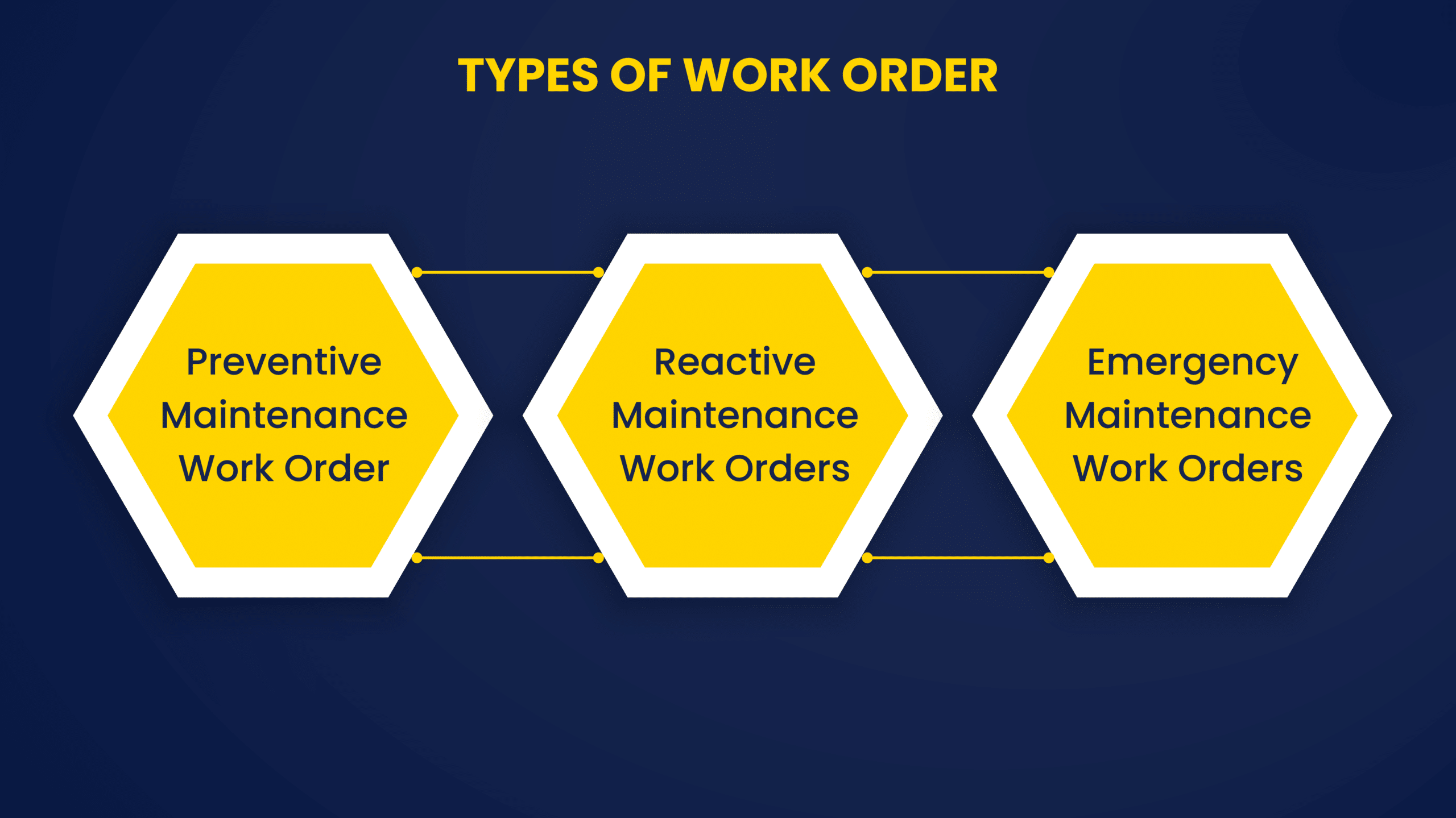Did you know that 80% of business maintenance costs come from reactive service instead of preventive maintenance?
Sounds expensive, right? It is!
Businesses that invest in preventive maintenance cut equipment downtime in half.
Yet, many still rely on outdated, reactive approaches that lead to unnecessary repairs, lost productivity, and skyrocketing costs. So, what is the key to avoiding these pitfalls? You have to understand the different types of work orders, i.e., Preventive, Reactive, and Emergency Maintenance, and use them strategically.
Work orders help to keep your operations running smoothly by outlining maintenance tasks, scheduling repairs, and ensuring technicians know what needs to be done and when.
If you want to optimize your workflow, cut costs, and boost efficiency, mastering the types of work order is a must. In this blog, let’s break down the types of word orders in detail. So that by the end of the blog you’ll have a clear understanding of these word orders and which one suits you best, without any further ado. Let’s get started.
What is a Work Order?
A work order is a documented request that outlines a specific maintenance task, project, or job. It includes key details like assigned personnel, required materials, and deadlines. Whether you’re running a manufacturing plant, a field service operation, or a facility management company, work orders ensure tasks are completed efficiently and on time.
Electronic equipment manufacturing serves as a prime example in describing work orders. A maintenance supervisor generates work orders through which maintenance issues are addressed whenever a machine breaks down. The work order describes that Machine X does not work and then provides procedures for testing electrical wiring, in addition to naming the responsible technician with a set timeline for resolving the issue.
Production work orders serve as critical communication tools that foster better interfaces between various departments. Work orders assist people in understanding their roles and tasks while demonstrating task progress to all involved parties. Work orders help businesses increase operational management efficiency, lower the frequency of mistakes, and maintain high productivity levels. Organizations use work orders as essential tools to manage their operational task execution efficiently.
Types of Work Order
1. Preventive Maintenance Work Order
Preventive maintenance work orders are scheduled tasks aimed at maintaining equipment functionality and preventing unexpected breakdowns. These work orders are proactive in nature and designed to identify and address potential issues before they escalate into significant problems.
Examples
- The execution of preventive maintenance work orders directly contributes to equipment performance stability while minimizing equipment failures. Here are some common examples:
- Inspections of heating, ventilation, and air conditioning systems, as well as regular filter changes and duct cleaning, create optimal HVAC performance with improved air quality.
- Reliable equipment longevity results from frequent lubrication of moving machinery parts, including bearings and gears.
- Scheduled inspections of electrical systems with circuit breaker assessment and safety testing help operators maintain both safety compliance and operational reliability standards.
Importance
Preventive maintenance work orders are essential for ensuring the longevity and efficiency of equipment across various industries. Their importance lies in several key areas:
- Cost Reduction: Preventive maintenance allows organizations to find potential problems early to minimize maintenance expenses through this strategy. Proactive prevention methods cut down the necessity for emergency repairs, which drive up both cost and operational disruptions
- Increased Equipment Lifespan: The combination of routine maintenance duties, which include equipment lubrication along with inspections and part replacement activities, leads to increased equipment operational lifetime. Replacing equipment becomes unnecessary, so maintenance costs are reduced, and the project achieves improved return on investment.
- Improved Safety: Safety hazards become detectable through preventive maintenance inspections, which ensure compliance with all health and safety regulations. The establishment of preventive measures through this proactive technique safeguards workplace personnel while decreasing unsafe incidents.
- Enhanced Operational Efficiency: The maintenance procedure prevents breakdowns and downtime, which enables smooth operation. Reliability is vital to both boosting operational productivity and fulfilling customer requirements.
- Data-Driven Insights Work orders managed effectively within preventive maintenance facilitate organizations in collecting performance data that helps them develop informed decisions about resource distribution and upcoming maintenance requirements.
2. Reactive Maintenance Work Orders
The process of fixing equipment or asset problems through reactive maintenance work orders starts only after failure detection occurs. Under this approach, maintenance begins only after assets reach a state of complete failure. The application of reactive maintenance occurs primarily with non-critical assets, which also have low operational consequences or safety risks.
Examples
Reactive maintenance work orders are initiated in response to equipment failures or unexpected issues that arise. Here are some common examples:
- Fixing a Leak: A work order may be created to address a leak in a water pipe, requiring immediate attention to prevent water damage and restore functionality.
- Replacing a Broken Component: If a critical machine part, such as a motor or pump, fails during operation, a reactive maintenance work order is issued to replace the damaged component.
- Repairing HVAC Systems: When an HVAC system malfunctions, leading to inadequate heating or cooling, technicians are dispatched to diagnose and repair the issue promptly.
Importance
Reactive maintenance work orders are crucial for managing equipment failures effectively and ensuring operational continuity. The significance of these work orders can be summarized in several key points:
- Immediate Response to Failures : The reactive approach to maintenance lets organizations handle equipment problems immediately after they appear to respond quickly to unanticipated equipment breakdowns. Rapid intervention at the moment of equipment breakdown supports businesses in reducing operational downtime and preserving overall productivity in industries where stoppage because of equipment failure would be disastrous.
- Cost Efficiency: The maintenance process of reactive methods delivers cost-effective solutions for inexpensive equipment or systems that are not essential to operations. Organizations maintain better control of their resources by providing maintenance assistance only during important events, thus saving costs linked to scheduled examinations.
- Resource Optimization: When a company sticks to reactive maintenance, it chooses to fix its urgent equipment problems before completing scheduled maintenance procedures. Staff deployment during this method occurs only when equipment malfunctions, which improves personal efficiency.
- Flexibility in Operations: The flexible nature of this maintenance strategy helps organizations stay agile in changing situations because fixed schedules do not restrict their actions. This maintenance strategy proves useful when equipment is of secondary importance because it enables a “run-to-failure” method that provides advantages under specific situations.
3. Emergency Maintenance Work Orders
Understanding the different types of work order-preventive, reactive, and emergency is essential for effective maintenance. Each type plays a unique role in ensuring operational efficiency, safety, and cost-effectiveness in any organization’s maintenance strategy. By implementing structured processes for these work orders, businesses can enhance structured processes for these work orders.
Example
Emergency maintenance work orders are critical for addressing urgent issues that can disrupt operations or pose safety risks. Here are some common examples:
- Plumbing Failures: A burst pipe that causes flooding in a commercial building requires immediate repair to prevent water damage and maintain safety.
- Electrical Issues: A power outage due to faulty wiring or a blown transformer necessitates urgent attention to restore power and ensure safety.
- HVAC Malfunctions: A sudden failure of heating or cooling systems in a facility can create uncomfortable and potentially hazardous conditions, requiring prompt repairs.
Importance
Emergency maintenance work orders are essential for addressing unexpected equipment failures and ensuring the continuity of operations. Their importance can be highlighted through several key points:
- Rapid Response to Critical Issues: Unplanned equipment breakdowns, together with safety hazards, qualify for emergency maintenance services. A fast response represents a fundamental requirement to lower equipment downtime and restore functionality because it supports productivity alongside service standards in every organization.
- Safety Assurance: Several emergency conditions result in severe dangers that threaten both employees’ security and facility assets. The emergency work order system identifies hazardous risks as top priorities since it allows for immediate action to safeguard employees as well as facilities from harm.
- Operational Continuity: Emergency maintenance solutions successfully address pressing problems in order to keep operations stable. Industries that experience major financial loss if service disruptions occur find emergency maintenance essential for their operations.
- Cost Management: Emergency maintenance operations have high upfront costs, yet effective emergency work order management leads to reduced maintenance expenses because it stops further damage from occurring, along with subsequent repair costs in the future 56.
- Foundation for Improvement: Each emergency situation creates useful data about system vulnerabilities. The investigation of these events enables developers to create better preventive solutions that decrease emergency frequency and enhance maintenance operations.
Role of Field Service Management Software in Managing Work Orders
Field Service Management (FSM) software plays a critical role in managing work orders and optimizing service operations across various industries. This detailed overview explores the capabilities of FSM software, how it streamlines scheduling, tracking, and reporting for different types of maintenance, and the benefits it provides.
Overview of FSM Software Capabilities
FSM software merges multiple operational features to boost field service operational effectiveness. Key capabilities include:
- Work Order Management: Work Order Management automation enables efficient processing of order creation together with assignment and tracking tasks.
- Scheduling and Dispatching: The scheduling combined with the dispatching feature adjusts technician schedules by considering their available skills and location relative to job sites, thus cutting down unproductive downtime.
- Mobile Access: Through mobile applications, workers obtain instant access to their jobs, customer files, and details about inventory material.
- Reporting and Analytics: The system provides reporting capabilities along with analytics by collecting data to measure service quality through measurement of technician performance job, timing data, and customer satisfaction scores.
- Customer Relationship and Management ( CRM): The CRM system manages complete customer records to deliver personalized service and establish effective communication.
Streamlining Scheduling, Tracking, and Reporting
Preventive Maintenance
The scheduling process of preventive maintenance becomes automated through FSM software by making tasks begin when usage thresholds are reached or specific time periods elapse. A properly implemented FSM software enables periodic maintenance execution that helps prevent equipment breakdowns.
Technicians receive notice about upcoming work so they can properly prepare using the required tools together with the required parts. The maintenance history database enables organizations to monitor operational records that assist them in creating better maintenance protocols.
Reactive Maintenance
An FSM software system enables rapid scheduling of unplanned maintenance operations that arise because of equipment breakdowns or client service demands. The platform performs automated technician assignments of qualified personnel by referring to real-time location information in order to identify the shortest available specialist.
Quick responses through this system help reduce customer wait periods as well as improve overall service performance. Real-time tracking capabilities provided by the system enable managers to see the current status of all reactive work orders.
Emergency Responses
FSM software implements an emergency response system that sorts work orders according to their critical nature. The system provides instant technician deployment combined with notifications that inform customers about approaching technicians. Emergency intervention outcomes and response time data reported by the software allow analysts to develop better protocols that become effective for future emergencies.
Benefits of Using Field Service Management Software
- Improved Communication
The FSM software system provides real-time notification capabilities that maintain current information about job developments between technicians and their customers. The clear visibility makes customers trust the service experience better because they know when their services will happen and if anything changes.
- Resource Allocation
Scheduling abilities within the FSM software allocate resources to technicians who possess appropriate skills and remain available for assignments. The optimized system plan reduces operational expenses by shortening journey durations while improving operational capability, resulting in more work potential without fixed cost increases.
- Enhanced Customer Satisfaction
The scheduling capabilities in FSM software help improve customer satisfaction because they let companies respond rapidly to service inquiries and maintain services proactively. Fast issue resolution through FSM software produces favorable customer interactions that build customer loyalty.
- Data-Driven Decision Making
Performance metrics become easier to analyze through Data-Driven Decision Making capabilities that exist within the system’s comprehensive reporting function. Service organizations can make better decisions about employee training and service improvements through the analysis of resource allocation data and technician performance metrics, as well as customer feedback records.
- Increased Productivity
Business productivity results from automating basic operations since staff members allocate their time toward essential activities that stimulate corporate expansion. The optimization of work processes through FSM software generates higher productivity levels that help technicians execute more jobs in an efficient manner.
FSM software is a vital tool for managing work orders effectively. Its capabilities in scheduling, tracking, and reporting for preventive maintenance, reactive maintenance, and emergency responses not only streamline operations but also enhance communication and resource allocation. As businesses continue to embrace digital solutions in 2025 and beyond, the role of FSM software will only become more integral to achieving operational excellence.
Takeaway
Businesses need to understand different work orders for effective optimization of their maintenance management approach. The approaches for work order execution must follow unique processes when addressing preventive maintenance, corrective actions, or emergency repairs. Organizations achieve maximum operational performance when they categorize work orders properly because this allows better resource allocation, smoother operations, and better service delivery.
Field Service Management (FSM) solutions, particularly Swivl, should become an essential choice for businesses because they smooth the management of these complexities. Swivl positions itself as the top FSM software available with advanced functionalities that optimize operational performance. The platform operates from the cloud to give technicians instant access to essential job information along with client details so they receive the required data on demand.
The Swivl platform promotes clear communication between office workers and field service employees thus cutting down confusion and acceleration response intervals. Swivl automates scheduling and invoicing operations to help teams deliver outstanding service by freeing their time from administrative tasks. Operations that use Swivl’s innovative tools can improve their maintenance management practices while simultaneously achieving market growth together with a competitive advantage.






